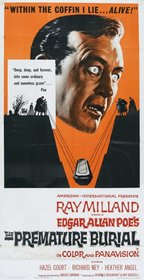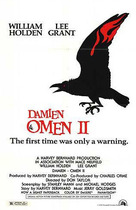Our editor-in-chief Nate Yapp is proud to have contributed to the new book Hidden Horror: A Celebration of 101 Underrated and Overlooked Fright Flicks, edited by Aaron Christensen. Another contributors include Anthony Timpone, B.J. Colangelo, Dave Alexander, Classic-Horror.com's own Robert C. Ring and John W. Bowen. Pick up a copy today from Amazon.com!
Premature Burial (1962)
Of the myriad number of authors in the realm of horror fiction, none have been better at examining and exposing the powerful demons within the human psyche than the legendary Edgar Allan Poe. Few filmmakers have been more adept at transferring Poe's stories to the big screen than Roger Corman. After huge financial successes with Fall of the House of Usher (1960) and Pit and The Pendulum (1961), it was little surprise that Corman would continue to mine Poe for box office cash in 1962 with the intense and disturbing Premature Burial.
The film is set in England and stars Ray Milland as Guy Carrell, a former medical student who is obsessed with the fear that he will be buried alive. He's convinced that a similar fate befell his father. Like the elder Carrell, Guy suffers from cataleptic attacks which leave him in an unconscious state with a pulse so faint that he appears to be dead. Terrified that he will be mistaken for dead and quickly buried, Guy builds an elaborate crypt with many fail-safe devices thrown in. Into his maddening world comes old flame Emily Gault (Hazel Court), who's intent on rekindling their relationship. The two end up marrying, but Guy's nightmare continues. Now he's hearing eerie noises at night and his nightmares are intensifying. Finally, after going to his father's crypt and seeing the face of frozen, wide-eyed fear on the corpse, Carrell collapses into a catatonic-like coma and his phobia of being buried alive becomes frighteningly real! Is Carrell going mad or is a sinister, murderous plot afoot?
With the Poe film series, Corman eschewed physical monsters familiar to his other horror works in favor of the mental demons that Poe himself centered on. With Premature Burial, Corman's talent for efficient direction and making the most of limited budgets actual works to the film's benefit. Corman strips the story of Burial down to its minimum, focusing almost exclusively on Carrell's unraveling mind and whether he's doing it all himself or being helped along. To achieve this, Corman turns Poe's tale into, essentially, a filmed play and puts the emphasis squarely on dialogue and the emotions of the main characters. There's a modest amount of Corman horror trappings on display (fog, Victorian sets, dim lighting) as well as bits of action, but they only serve as the framework for a grim personal drama. By putting the Carrell character under the intense scrutiny, Corman makes the film much more realistic and terrifying.
You would think that, with the pared-down angle Corman took to this movie, the art direction and cinematography would only have a remote chance at best of being a plus for Premature Burial. In fact, art director Daniel Haller makes the absolute most of sets re-used from Fall of the House of Usher and Pit and the Pendulum to help build the all-important gothic atmosphere crucial to the proceedings. Haller even throws in dollops of fog to add to the creepiness. Floyd Crosby's camerawork completes the technical polish with an array of dim lighting, odd camera angles, and use of color. The latter is notably evident in a weird, blue hue-infused dream sequence mid-way through the action.
Screenwriters and frequent Corman collaborators Charles Beaumont and Ray Russell take on the difficult job of fleshing out the Poe's characters and opening up the action for cinema audiences. They meet the challenge by providing crisp dialogue and adding bits of murder mystery. They also make the main characters of Guy and Emily more three-dimensional than usual for a genre film. There are layers to the two that Beaumont and Russell strategically unfold throughout the story that give the film needed twists. Gripped with his obsession early on, Carrell finds inner strength with Emily's arrival and, with his marriage to her, seems to find a confidence and happiness at last. There's even hope that he will win against his demons, until a twist in plot rips apart the fragile normalcy he's created. Conversely, Emily already has layers when the audience is introduced to her and those layers are unfolded by way of removal. When first seen, she has a veneer of longing and loneliness that quickly gives way to fear about Guy's precarious mental state. Once the two are married she, like Guy, appears to be happy and hopeful. As the last cover is taken off of Emily in the surprise finale, her true personality is revealed.
A film that takes a psychological approach to its material must rely heavily upon the actors to bring the story across. The cast of Premature Burial is more than up to the task and is uniformly fine. Ray Milland in particular does a superb job of portraying a man teetering on the precipice of total mental collapse. Underplaying nicely, he removes all barriers to offer a raw look inside Carrell's mind and the war waging within.1 Hazel Court shines in support as Emily, offering a shady mystery lady. Dick Miller even pops up in a neat cameo as a seedy grave robber.
Premature Burial, in an odd way, is a prime example of how two artists can come from distinctly different eras and still have an almost kindred approach to a subject. Both Roger Corman and Edgar Allan Poe knew how to present the scary, ugly side of human frailty like few others. One wonders, if Poe were alive in the 1960s, what kind of film could he and Roger Corman have done together? Whatever it would have been, it would make a great psychology class subject. If you're a student in that Psych 101 class and need research for a thesis on the subject, don't reach for that book on the wall. Go to your local DVD store and pick up Premature Burial, a celluloid analysis of fear, madness and, oh, the ever so slight phobia of being buried alive.
This review is part of our Shocktober Classics 2009: Staff Screams event.
- 1. Milland is subbing for regular Corman/Poe star Vincent Price, who was unable to do the film due to a contractual snag. Corman intended to make Premature Burial with the film lab Pathé, since he had a dispute with American-International over the profits on Pit and the Pendulum. Price was under contract with AIP and couldn't make Poe films with any other studio, so Corman had to replace him with Milland. The irony is that AIP chiefs Sam Arkoff and James Nicholson bought out Pathé's share of Burial the night before principal photography began. Source: French, Lawrence. "California Gothic: The Corman/Haller Collaboration." Video Watchdog. 138 (2008).








